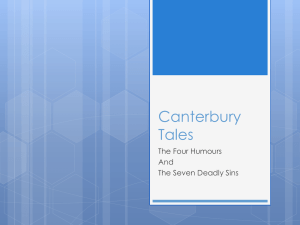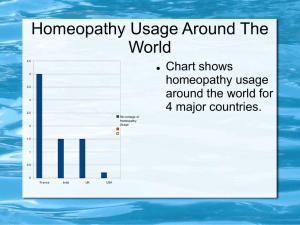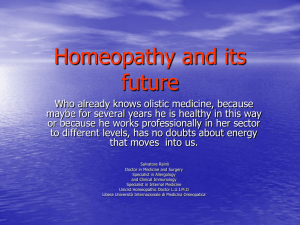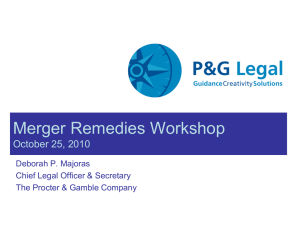Visual Homeopathy
advertisement
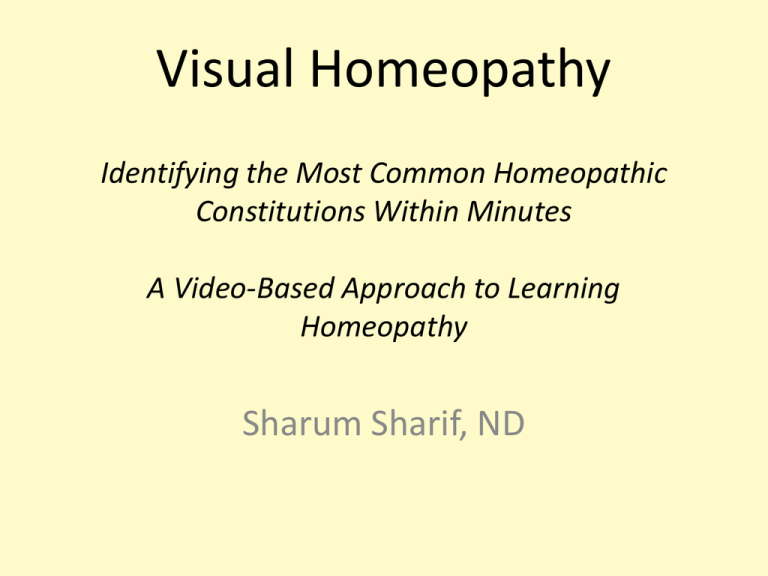
Visual Homeopathy Identifying the Most Common Homeopathic Constitutions Within Minutes A Video-Based Approach to Learning Homeopathy Sharum Sharif, ND Biography • Received ND degree from Bastyr University in 2003. • Practice in Kent, Washington. • Received undergraduate degree in Electrical Engineering from University of Washington. Worked as a software engineer for Microsoft and other software companies for about 5 years prior to going to Bastyr. • Completed a two-year course through NESH (New England School of Homeopathy). • Attended many seminars by Henny Heudens-Mast. • Affiliate Clinical Faculty at Bastyr University. • Specialize in complex conditions that are not responding to allopathic or conventional naturopathic therapies. Why am I here today? I find that most NDs, unfortunately, do not use homeopathy in their practices, and if they do, they often end up prescribing mainly on physical keynotes and recommend the wrong remedies because they are NOT carefully taking the patient’s personality profile into consideration. As a result, they are often unable to help their patients, and in some cases, even hurt their patients with the wrong remedy. I am here to share with you: 1) How important it is to use homeopathy in your practice 2) How easy it can be to learn basic homeopathy Why Homeopathy? 1) The remedies are the most effective tool we have in combating a myriad of serious ailments (including suicidal depression). 2) Due to the deep-acting nature of homeopathic remedies, if they are chosen properly, they are often the most curative medicines available for the treatment of disease. 3) The remedies are extremely inexpensive, and can easily be made available to everyone on the planet (especially in the case of a pandemic). 4) Homeopathy is planet friendly- we don’t have to worry about running out of natural resources like we do with herbs. 5) The remedies are extremely convenient. In the treatment of chronic illness, patients only need to take their remedies, on average, once a month, and they improve on all levels (physical, mental, and emotional), and continue to improve until they are healed. Note: Dr. John Bastyr’s most favorite modality, in his own words, was homeopathy. Articles on “Why Homeopathy?” Under the page “Why Homeopathy?” on the www.VisualHomeopathy.com website, you will find two articles on this subject: 1) First article: “Advantages of Homeopathy” 2) Second article: “Advantages of combining naturopathic medicine and homeopathy” Examples to demonstrate the effectiveness of homeopathy Refer to the testimonials on www.DrSharif.com or www.VisualHomeopathy.com. Examples: • Video of a boy with warts, before and after • Video of a patient with suicidal depression, before and after • Video of a patient with neurological symptoms post concussion • Video of the Alumina case, with hx of elevated Al levels • Video of the man with 6-month long headache who was cured in 10 minutes (Note: The patients’ remedies are listed only on the www.VisualHomeopathy.com site.) Is homeopathy by itself sufficient in healing your patients? In many cases, yes. And, in many cases, no. In children, homeopathy is often sufficient in curing their various ailments. In adults, however, you will find that you have to use all the tools available to us as naturopaths in order to help your patients completely heal from the various chronic ailments they are suffering from. (Refer to “7 Steps to Healing” article on my clinic website, www.DrSharif.com, for more information. Note: Constitutional homeopathy is only one of the sevens steps to healing even though it may be one of the most effective therapeutic tools available to us.) What is Visual Homeopathy (VH)? Who can practice it? “Visual Homeopathy” (VH) is a term I developed to describe a video-based approach to learning homeopathy rather quickly. Cases are taken by keen visual observation and carefully listening to the patient. In some cases, I might ask a few questions to confirm my assessment. The VH technique is developed to encourage ND’s to incorporate basic homeopathy into their practices. Does the word “visual” mean that you don’t listen or talk to the patient? No. The word “visual” in “Visual Homeopathy” does NOT imply that you do not listen or talk to the patient. I initially came up with the word “visual” since I found visual observation of my patients to be the most helpful aspect of the case-taking process. Visual Homeopathy Seminars and Seminar Notes • I offer weekend seminars on Visual Homeopathy a few times a year at various naturopathic schools. We watch short clips from a pool of over 500 actual patient videos and Hollywood movies demonstrating the various remedies. (We watch numerous videos for each constitutional type.) • Presently, my Visual Homeopathy book is available through the Bastyr bookstore as well as my clinic: www.DrSharif.com • The seminar notes (around 40 pages) for the VH seminars are available free of charge on the website: www.VisualHomeopathy.com Format of the VH Seminars • Set 1 (15 or more videos, one for each main constitution) • Set 2 (15 or more videos, one for each main constitution) • … • Set 15 (15 or more videos, one for each main constitution) Note: The cases get more and more difficult as you progress from set 1 to set 15. You are initially not told what a person’s remedy is, and are supposed to find it yourself using the tools you are given in the class. Format of the Seminars, part 2 • All the videos are also arranged in a second format: – Calc carb folder (all the videos in this folder are Calc carb) – Pulsatilla folder (all the videos in this folder are Pulsatilla) – Phosphorus (all the videos in this folder are Phosphorus) – …. Pre-requisites for the VH Seminars? No. Although it would be helpful to have taken the beginning homeopathy classes at a naturopathic school. What is Constitutional Homeopathy? A “constitutional” homeopathic remedy matches the person on the physical AND mental/emotional levels, and thereby can significantly help a person on all three levels. The patient’s personality traits and behavioral patterns are absolutely key in finding the “constitutional” remedy. How many common constitutional types are there? In my opinion, you will see 15-20 constitutional types very commonly in a primary care naturopathic practice. We cover these constitutions in the book as well as in the weekend seminars. What is acute prescribing and how does it differ from constitutional prescribing? “Acute” prescribing is what is routinely utilized by most naturopaths. As helpful as this can be in many situations, it is not nearly as powerful as “constitutional” prescribing. The reason is that an acute remedy is only addressing a few of the patient’s symptoms, as opposed to a constitutional remedy which captures the patient in his/her entirety, covering physical as well as mental/emotional aspects of the patient. Identifying a Red Rose… Do you need a plant identification book to identify a red rose? Identifying Calc carb, Phosphorus, or other very common (polycrest) constitutional homeopathic types is just as simple as identifying a red rose! Using the Visual Homeopathy technique, you can easily identify most of your patients’ constitutional remedies within minutes. Do you have to repertorize to find a person’s constitutional remedy? In most cases, the answer is no. Using the Visual Homeopathy techniques, you do not have to spend hours trying to find a person’s constitutional homeopathic remedy by “repertorizing” a case. In fact, I rarely repertorize my patients, and find the correct remedy in nearly every case. Repertorization is useful if you do not know a patient’s remedy with a high level of certainty using the VH techniques, or if they are not a top polycrest. What is needed to practice VH? 1. A familiarity with the ESSENCE of each of the top remedies, and their main few traits. 2. Astute observation skills to discern the ESSENCE of the patient. With just a little training and practice, you can easily become very proficient in this approach to constitutional prescribing. Two-step approach to VH prescribing 1) Know the main features of the most common constitutional types or polycrests. AND 2) Match the patient to one of these remedies. Interpreting human behavior is critical in constitutional homeopathy Interpreting human behavior is the emphasis of my weekend seminars. Finding the correct remedy is not as much about learning the numerous details regarding each homeopathic remedy as it is about learning how to identify various human traits. Challenge #1 in Constitutional Homeopathy The most important word of caution in constitutional homeopathy is that you must not be fooled by the patients’ superficial words and gestures: Not everyone who is angry is Nux vomica, and not everyone who smiles is Phosphorus! Challenge #2 in Constitutional Homeopathy The fact that no two individuals of the same constitution are identical is another major difficulty in finding the correct constitutional homeopathic remedy for a person. Some of the VH descriptions are very unique… Since I am looking at the remedies from a kinesthetic/energetic viewpoint, I have included certain information about the main polycrests in my book that is definitely not found in other homeopathy books. Examples: • Carcinosin has a “tight” energy. • Silicas are most often very thin, and appear like the cartoon character “Pinocchio”. This sort of information is meant to be a memory aid for students. • The “three I’s of Ignatia”: irritable, industrious and idealistic. Look at and listen to your patients very carefully • In order to properly interpret your patient’s behavior and personality characteristics, you will have to be very observant and attentive while talking to your patient (or watching the VH videos). • You are trying to learn the essence of the patient, and should not be confused by superficial aspects such as the patient’s nationality, gender, age, educational background, etc. The main three VH tools 1) Polycrest Table: This table contains the main traits of the most common polycrests. 2) Polycrest Algorithm: Classification of the top polycrests into three categories. 3) Intensity Graph: Categorization of the top polycrests based on their “intensity”. I) Polycrest Table Refer to the one-page word document in your handouts. Polycrest Table This table contains the main traits of the most common polycrests. Note that many remedies can have the traits listed in each box; the ones listed are the most likely to have that trait. For example, under “very sensitive and gentle”, I have listed Nat mur and Pulsatilla. This does not mean that other remedies cannot be sensitive and gentle; however, these two remedies are definitely on the sensitive and gentle side. You should be able to sense these traits, but can also ASK… You should be able to sense many of the traits listed in the Polycrest Table yourself, and not have to ask the person whether they possess them. Patients are not going to volunteer a lot of this information. Additionally, most of us cannot see all of our own personality traits (especially the “bad” ones)! If you see the word “ASK” next to a word in this table, it means that you may simply be able to ask the patient whether they possess that particular trait or not. Patient’s Choice of Words… • I would NOT completely trust in the words patients use to describe their personality traits or behavioral patterns. So, you must have a clear mind and a non-judgmental attitude to come up with an accurate understanding of your patients’ traits. For example, often patients use the words “defensive” to mean “aggressive”. Or, “anxious” to mean “irritable”. Practitioner’s Choice of Words… • In order to accurately come up with a person’s remedy, you must get your words/concepts straight. If you do, then the Polycrest Table can be of great help. For example, Nat murs are mild, and what I’d call “soft”. However, they are NOT “warm/sweet”. Pulsatilla and Phosphorus individuals tend to be all the above. How to find the remedy using the Polycrest Table • Identify the traits in boxes that best capture your patient, such as soft, organized, etc. • Find the remedies that are in common amongst the boxes you picked. • Choose the one remedy from this list that matches your patient the best. • Finalize your opinion by referring to ALL the keynotes under the algorithm section in the Visual Homeopathy book or notes (or any Materia Medica) for the remedy you have picked. EXAMPLES for use of Polycrest Table 1) Soft and organized: The only remedy in common between these two boxes is Carcinosin. 2) Hard working and irritable: The only remedy in common is Ignatia. 3) Serious and flat affect: The only remedy in common is Kali carb. II) Polycrest Algorithm This algorithm classifies the top polycrests into three categories: • 1) “Soft and Sweet” - Pulsatilla, Phosphorus, and Carcinosin. • 2) “Angry/Irritable” – Nux vomica, Lachesis, Ignatia, Causticum and Kali carb. • 3) “The Others” - Calc carb, Nat mur, Sulphur, Sepia, Staphysagria, Silica, Medorrhinum, and Lycopodium. Meaning of the terms in the Polycrest Algorithm • 1) “Soft and Sweet”: The remedies in this category almost always smile at you. They are often soft, sweet and warm-hearted. • 2) “Angry/Irritable”: These remedies tend to be angry and/or highly irritable. • 3) “The Others”: This category includes constitutional types that do not nicely fit into the “soft and sweet” category nor the “angry/irritable” category. The key in using the Algorithm The key in using the Polycrest Algorithm is in being able to correctly put your patient into one of these three categories. Ask yourself during the interview, what state is the patient in for the MAJORITY of the time? Example: Anyone can be angry, but is every constitution angry much of the time? No, but Nux vomica has a constant undertone of anger to their personality, and is therefore listed under the “angry/irritable” category. Animal analogies in the algorithm For each of the main remedies, I have noted an animal that best captures the essence of that remedy. The animal analogy is written in parenthesis. A person is a subset of a remedy, not vice versa!!! Not all of the statements about a particular remedy have to be present in every person who needs that remedy. For example, not all Sulphurs have to be lazy. Not all Pulsatillas are thirstless. ***Comparison and contrast between similar remedies… In the “Seminar Notes” available at www.VisualHomeopathy.com, I have written about how similar top polycrest remedies compare and contrast. If you are stuck between two very similar remedies, you will find the comparison and contrast section useful. For example, if you are trying to decide whether your patient is Pulsatilla or Phosphorus, both of which are in the “soft and sweet” category, then you should refer to this section. Which physical symptoms/keynotes are important? The physical symptoms listed under each remedy in my notes are what I consider to be the MOST important ones because you will most likely actually encounter these in your patient population. Examples: Nat mur is often dry. They are often constipated and/or have dry skin. Phosphorus has weak lungs, and females tend to have heavy menstrual bleeding. Pulsatilla is typically thirstless despite of having a dry mouth! How do I use the physical keynotes? I first pick a remedy that matches a person’s personality traits and behavioral patterns. THEN, I will use the physical keynotes as “confirmatory” symptoms. Example: Once I see a reserved and polite person who matches the constitution Nat mur, then I ask them about dryness in their body: “Do you tend towards constipation? Do you have dry skin?” And, Nat murs often do have dryness in their body. 1. “Soft and Sweet” Remedies: Black or dark brown hair Carcinosin Blond, light brown or red hair Phosphorus or Pulsatilla Is the patient’s hair color natural? In using the previous illustration, you need to know if the patient’s hair color is natural, or is it dyed? I have never met a Carcinosin patient who does not have dark hair! However, Pulsatilla and Phosphorus individuals can come with any hair color. Realizing the above point can be useful in helping you identify a person’s constitutional remedy if they are in the “soft and sweet” category. Pulsatilla (Woody Allen, Betty White, Jonah Hill) • • • • • • • • • • • • Emotionally, very young for their age Very mild and soft, and often sweet Emotionally needy/clingy- loves to hug. People pleasers. “Mama’s baby” Very weepy. Sometimes can’t control crying Very social Can be annoying and/or hyper SRP (Strange-rare-and-peculiar): Thirstless, but often with a dry mouth Easily changeable mood. Emotional swings (Bipolar type) Often are blond in the U.S. Pulsatilla men are often effeminate. Ear infections even in adults (Kids get a lot of ear infections too) Animal analogy: Baby animals of all sorts such as baby duck or baby chick, or a cat when it’s curled up on the couch. Carcinosin (Alexis Bledel) • Very kind and sweet (probably the kindest remedy, even more than Phosphorus) • Often has romantic eyes • Has many fears and worries • “Tight” energy (a bit tense, but not forceful) • Why tense? Because of too much fear/worry • Black or dark brown hair (I’ve never seen a blond Carcinosin) • Clean and organized (fastidious) • Has significant digestive problems • Passionate people who have a sense of longing/romance in eyes • Loves to dance (in most cases), in order to release her tension. • Sometimes uncomfortable socially (trying too hard to be nice) • Blue hue to their sclera • (Animal: lovebirds) Phosphorus (Julia Roberts) • Warm and very social (can socialize with anyone) • Relaxed like Sulphur (but not arrogant like Sulphur) • Expansive (especially the large body type) and dispersed energy (as opposed to Carcinosin whose energy is tight). • Often has scattered thinking • Bubbly personality and very talkative • Very comfortable in social settings (versus Carcinosin which is uncomfortable socially) • Emotionally independent and stronger (as opposed to Pulsatilla who is needy and dependent on others) • Tendency towards respiratory problems (chronic cough, asthma, recurrent bronchitis or pneumonia in cold months, etc.) • Tendency towards heavy bleeding (nasal, menstrual, etc.) • Least controlling of all the polycrests • Animal analogy: Bunny 2) Angry/Irritable Remedies • • • • • Causticum Ignatia Kali carb Lachesis Nux vomica Causticum • All about social welfare/justice for all; often involved in volunteer activities to help a social cause • Great anger over injustice • Very sincere • Always strong personalities • Sometimes irritable. If irritable, their irritability might feel a bit like Ignatia. • OCD (checking and rechecking tasks compulsively) • Body temperature is cold • Almost always have some neurological symptoms Ignatia (Kathy Bates, Catherine O’Hara, Diane Sawyer) • • • • • • • • • • Three I’s of Ignatia: Irritable, Industrious, and Idealistic. Raw nerve feeling about them (irritable) Touchy and cranky Type A Often high strung and idealistic, works hard to reach her ideals Predominantly a female remedy Sighs often to release the tension inside Can be very critical of others Connects well with others Body temperature is not an issue (unlike the other intense remedies) • Sometimes there is a feature in her face that is not normal • The shape of the lips is often a giveaway- they reflect anger • Animal analogy: A cat whose tail is being stepped on Kali carb • • • • Very rigid, inflexible and emotionally dry Extremely organized Very serious (often intimidating to others) Cannot read the emotion behind their eyesVery cold and impersonal feeling about them • Similar to military officials Lachesis • Passionate and intense • Aggressive • Very verbal and enjoys engaging with you emotionally during the interview • She feels hot/warm physically. • Often has left sided symptoms • Animal analogy: Snake Nux vomica (Dr. Oz, Michelle Rodriguez, Sigourney Weaver) • • • • • • • Serious and angry Type A and discontent Extremely hardworking Very masculine (males and females) Very organized Body feels cold Usually, she has definition to her facial bones (unless very overweight) • Animal analogy: Lion 3) “The Other” Common Remedies • • • • • • • • Calcarea carbonica (Calc carb) Lycopodium Medorrhinum Natrum muriaticum (Nat mur) Sepia Silica Staphysagria Sulphur Calcarea carbonica (Calc carb) • • • • • • Very hard working Very stubborn Harsh/tough energy, but not intense Emotionally and intellectually simple people Always chubby or overweight Animal analogy: Ox Lycopodium • Bossy towards those with less authority • Subservient and respectful (due to fear) towards those with more authority • (The above makes Lycopodium. more difficult to perceive than other constitutions.) • Very intellectual, serious, and emotionally dry • Poor self-esteem and feelings of inferiority • Some are introverted and some are extroverted • Often has abdominal bloating and liver problems • Similar to Nux v. in that it is a great remedy for liver problems • (Lycopodium is found in UNDA #243 and #1, both are for liver.) • Often right-sided problems • Often has deep brow furrows • (Animal analogy: Owl. Owls are quiet thinkers.) Medorrhinum (Leonardo DiCaprio) • Extremist in all ways: physically, mentally, and emotionally • Most are excessively and often inappropriately social (more social than Sulphur and Phosphorus); some are excessively reserved and timid • Gazes right into your eyes • Full of desires, yet many fears • Better with discharges; develops severe illness with suppression of d/c (Animal: A puppy) Natrum muriaticum (Nat mur) (Colin Firth) • Reserved and “closed” (averse to consolation, at least when initially upset) • Quiet and not very talkative • Very proper • Vulnerable and gentle (overly sensitive) • Can get teary-eyed easily • They can be the nicest people- even nicer than the “soft and sweet” category, but are not necessarily “sweet”; they are just nice and proper • Often artistic • Perfectionist • Body is on the dry side (look for constipation and/or dry skin) • Animal analogy: Turtle with head tucked in • Nat mur actor: Colin Firth playing the role of father in “Nanny McPhee” Sepia (Sylvester Stallone and Queen Latifah) • STASIS OR CONGESTION IS THE MAIN THEME • Often (not always) flat affect and flat voice- She is unexcitable and appears bored • Can be nasty and rude when upset (or even when not upset) • Has a cool and “I don’t care” attitude • “Sepia” (sallow yellowish brown) colored skin • Sepia women often have gynecological problems Silica (Estelle Getty ) • • • • • • • • • • Very poor physical health (numerous physical ailments) Extremely organized Extremely detail oriented Extremely stubborn (but can also give in easily, as opposed to Calc carb who is stubborn and does not give in.) As a rule, not the warmest personality Can physically carry themselves like royalty Often very thin, and never fat (as opposed to Calc carbs who are always chubby or overweight, and are never thin) Almost always have constipation and/or other GI issues Animal analogy: Mouse Actress: Estelle Getty as Sophia (the grandmother in Golden Girls) Staphysagria • Shy • Suppressed anger/frustration (ready to explode) - You can feel the anger under the surface, in an overall nice person. (This is in contrast to Nux vomica, whom you will definitely know is angry- it won’t be under the surface.) • Comes across as sweet/polite (but not as sweet as the people in the soft and sweet category) • They internally feel as if they are royalty- feel superior to others. However, they do not act prideful or carry themselves as if royalty like Silica might. • High libido Sulphur (Ted Levine- Captain in TV Show Monk) • Social • Intellectual, always trying to figure things out, and has an opinion about everything • Often arrogant • Some tend to be lazy and messy • Relaxed body language. Their relaxedness is similar to Phosphorus • Feels warm/hot • Often has problems with skin and/or acid reflux • Actors: Ted Levine playing Captain in TV show Monk. And, Matthew Gray Gubler playing Dr. Reid in TV Show "Criminal Minds"; If he is not Sulphur, he is certainly acting like one. 3) Intensity Graph Spikes on the Intensity Graph This graph is a major overgeneralization, and does not represent all possible states of each remedy. It shows, in a simplified way, the general essence of each of the most common remedies based on their intensity. The spikes in the graph represent anger or emotional outbursts. Pointy spikes represent more intense (and tense), abrupt outbursts. Rounder spikes are softer and gentler outbursts. More on the Intensity Graph • Very intense and angry: Nux vomica, Lachesis, Causticum, and Ignatia • Medium to high intensity: Sulphur • Medium intensity: Calc carb (very level energy in a rather healthy way) • Medium to low intensity (lively, but not angry): Carcinosin, Phosphorus, and Pulsatilla • Low intensity, but w/ intense anger outbursts: Staphysagria • Low intensity: Silica and Nat mur • Low intensity and energetically “flat”: Sepia (Note: Not all the top remedies can be illustrated on this graph.) Polycrests versus Non-polycrests… If your patient’s mental/emotional picture does not match any of the main polycrests, then you are likely dealing with a nonpolycrest constitution. It is far more difficult to find a remedy for your patient if they have a constitution that is not a poly-crest. Choice of Potency • The subject of dosing/redosing can be rather complicated. I have a whole section in my book on this subject. Summary: • I’d recommend starting out with a 200C unless you are not confident of your choice. • If not confident of your choice, you can give 30C. • If very confident, and if the person is not too chronically ill, give 1M. • Children do great with 1M. Adults with numerous health conditions may get aggravated with 1M, so should start with lower potencies such as 200C (or if not confident of your remedy choice, 30C). • For mental/emotional, I’d recommend higher potencies such as 1M, or even 200C. Lower potencies are not nearly as helpful on the mental/emotional level as the higher potencies. How often to dose? Higher potencies seem to last much longer. A 12C or 30C may last hours/days; however, the 200C/1M may last weeks. During acute conditions such as the flu, patients often require their remedy more often than when they are being treated for their chronic illnesses. -For acute illnesses, dosing may be as often as once every 1-2 days. -For chronic illnesses, dosing is often needed once every several weeks, on average once a month. How do you know when to redose? • Basically, when the benefits of the previous dose of the remedy has mostly worn off, it’s probably time to offer the next dose. • Note that the benefits may be on mental/emotional as well as physical level. – Ex: Constipation and depression in a Nat mur. If the remedy is helping both, but after a few weeks, the depression returns full force, but the constipation is still better, you can redose. How often to redose? • Patients often love their remedy, so they want to take their remedy very often. As you know, if you take your remedy too often, you can “prove” it; in other words, develop the very symptoms you are trying to treat! • So, a good rule of thumb I share with my patients is: – If you are having 1-2 “bad” days, that does not mean you need your remedy. (“Bad” means feeling as if your remedy has worn off by at least 50%.) – If you continue to feel very badly, then you can consider redosing. Does coffee really antidote homeopathic remedies? • Refer to the “coffee” page on www.VisualHomeopathy.com for more information. • Unfortunately, coffee (regular or decaf) almost always antidotes single dose homeopathic remedies. • The antidoting effect can be complete and immediate versus partial and gradual. – In other words, for one person, one cup of coffee can entirely antidote their remedy within minutes. For another person, one cup may antidote their remedy by 20% every time they drink it. Let’s watch some patient videos… How are you going to learn these top remedies very well? Reading homeopathy books by itself is definitely not sufficient in finding the correct constitutional remedy for your patients. The VH tools discussed here are meant to help you, but are not a replacement for actual patient observation (either in person or on video). Basically, you need to closely observe at least several people of the same constitution to develop a feeling for that particular constitutional type. Start With… • In my experience, – It’s much easier to find a woman’s remedy than it is a man’s remedy. – It’s much easier to find an adult person’s remedy than it is a child’s remedy. – It’s much easier to find a native person’s remedy than it is a non-native person’s remedy. Watch the patient videos on www.VisualHomeopathy.com There are numerous actual patient videos on the Visual Homeopathy website (on various pages). Creation of this website has taken much time and financial resources. Please feel free to take advantage of this extensive learning tool. Visual Homeopathy Book The Visual Homeopathy book covers: -The three main ideas in VH, including the algorithm, the table, and the intensity graph. -Materia Medica of the most common polycrests, with comparison and contrast among these remedies -Practical information on dosing and re-dosing -Key questions to ask patients -Definition of what I mean by certain words in Visual Homeopathy (such as intensity, sweet, etc.) -What each constitution can expect from their remedy -Mechanism of action of homeopathy -Other ideas on homeopathic theory and practice Homeopathy and the Pandemic Flu What is the Genus Epidemicus? It is a remedy which is found to be curative in the majority of cases of the same disease (i.e. epidemics or pandemics). Hahnemann taught that the genus epidemicus remedy should be chosen by the uncommon characteristic symptoms of all the patients, not the common symptoms of the epidemic disease. Homeopathy and the Pandemic Flu Check out Dr. Paul Herscu’s website on the flu: http://www.hersculaboratoryflu.org/ Herscu Laboratory has developed a number of tools that may be useful in the tracking and clinical treatment of the current flu pandemic. One of the tools is a questionnaire that tells you if the patient is a good candidate for the genus epidemicus remedy. More Videos to be Posted on www.VisualHomeopathy.com I will be placing more videos on the VH site every once in a while as I gather new ones. Therefore, keep checking this site periodically if you are interested in watching more videos. Hollywood and Homeopathy… On the www.VisualHomeopathy.com site, you will find a growing list of famous individuals and their suspected constitutional remedy. Summary • Profile the patient into one of the 3 categories: soft/sweet, angry/irritable, or “the others”. This narrows your choice down to a few remedies. • Use physical symptoms to confirm your choice. • Read the comparison/contrast section online or in the book to figure out the exact remedy. • If not confident, start with a 30C potency. – If the 30C helps at all on any level (mental/emotional/physical), when it wears off, then prescribe a 200C potency. – If the 30C doesn’t help, either your choice was wrong, or the 30C was not strong enough, or the person is too ill to show any reaction. You can purchase a copy of the Visual Homeopathy book here today, or through the Bastyr Bookstore or my clinic. Patient Videos and VH Seminars Available on the Internet I am currently looking into making the remainder of my patient videos (over 500) available on the internet for a fee so that you can view them at your own convenience. If you are interested, please email me so that we can contact you when this service is available. Note: For some common constitutions (such as Phosphorus or Pulsatilla), I have over 40-50 actual patient videos. For some other less common constitutions, I might have only a few. Contact Information • • • • Speaker: Sharum Sharif, ND Email: SharifND@yahoo.com Clinic website: www.DrSharif.com Teaching website: www.VisualHomeopathy.com • Email me if you would like to be notified of future classes. Thank you for your interest in homeopathy! In my opinion, homeopathy is the most effective tool we have in combating pandemics and a myriad of serious ailments such as autism and depression. Therefore, it brings me great joy to help make homeopathy easier to learn for students as well as practitioners of homeopathy.

